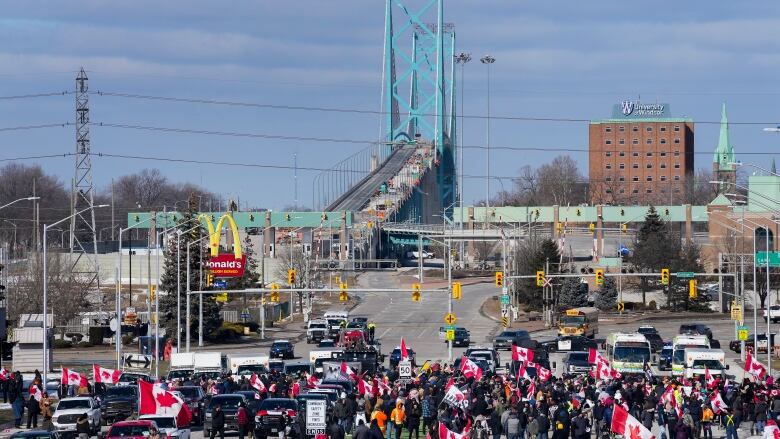Clearing Ambassador Bridge blockade quickly would have 'inflamed' protesters: police chief
Interim chief says the protest leaders changed so frequently that negotiations wouldn't stick

Windsor's interim police chief says the Ambassador Bridge blockade could have been cleared in less than half an hour,but doing that would have "inflamed" protesters and someone could have gotten hurt.
That's according to a new interview summary included in a Public Order Emergency Commissioninquiry into federal use of the Emergencies Act.
The federal government used the act after convoy blockades in Ottawa and Windsor protesting COVID-19 restrictions and vaccine mandates. In the summary, Jason Bellaire, interim chief of Windsor Police Service (WPS), said his service took a "methodical and cautious approach" to removing vehicles.
"He explained that, while the police could have cleared the Ambassador Bridge in less than half an hour, doing so would have risked injury and inflaming the protests and would have been contrary to WPS values," the summary said.
Bellaire also said the protesters were "difficult to negotiate with because there were multiple groups of protesters and their leaders changed frequently."
In one instance, it said, police negotiated with one group of protesters to leave some lanes open, "only for another group to block those lanes."
"The protesters were so unstructured and their leadership so fragile that it was difficult to reach agreements or prevent agreements reached from falling apart. Interim chief Bellaire's view was that the protesters' loose organization made their behaviour unpredictable.
"Interim chief Bellaire further observed that the protesters became more aggressive at night due to alcohol consumption. Officers accordingly avoided engaging with protesters at night so as not to stimulate violence."
The hearing is to examine the federal government's use of the act after weeks of protest.
On Jan. 28, protesters began to arrive in downtown Ottawa to express their anger. That protest lasted more than three weeks.
In Windsor, the Ambassador Bridge the country's busiest trade corridor to the U.S. was blocked starting on Feb. 7 and it reopened on Feb. 13.
The federal government used the Emergencies Act to declare a public order emergency on Feb. 14.
A new Windsor police debriefing, released as part of the inquiry documents, says the protest blocked $450 million in goods and cost the auto industry alone $988 million.The debriefing also shows the protest cost Windsor police $5.1 million, including $2.5 million in overtime.
Windsor Mayor Drew Dilkensand Jason Crowley, Windsor's acting deputy chief,are scheduled to testify next week.
On Monday, former Ottawa police chief Peter Slolyfaced cross-examinationdefending his officers' actions during the Ottawa occupation.












_(720p).jpg)


 OFFICIAL HD MUSIC VIDEO.jpg)
.jpg)



























































































